Frederic Leighton
Paintings
Lucia
Lachrymae
Cymon and Iphigenia
Idyll
Wedded
Pan
Perseus and Andromeda
Winding the skein
Lindos Rhodes
Orpheus and Euridice
Cimabues Celebrated Madonna is carried in Procession through the Streets of Florence
Garden of an Inn. Capri
And the Sea Gave Up the Dead Which Were in It
Elijah in the Wilderness
David. Oh, that I had wings like a Dove. For then would I fly away, and be at rest. Psalm 55.6
Venus Disrobing for the Bath
Bacchante
La Nanna. Sunny Hours
Venus and Cupid
The Isle of Chios
Portrait of May Sartoris, Mrs Henry Evans Gordon
Lucia
Lachrymae
Study for Clytie
Drapery Study of the Seated Girls watching the Festival Procession in the Daphnephoria


Actaea, the Nymph of the Shore
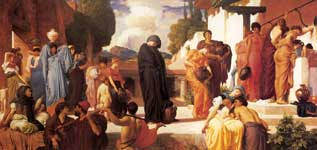
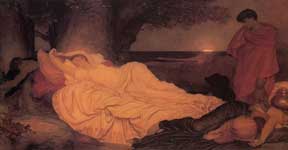

Electra at the Tomb of Agamemnon
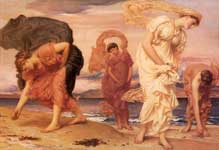
Greek Girls Picking up Pebbles by the Sea

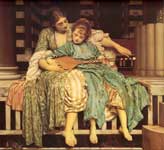

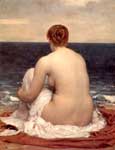
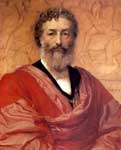
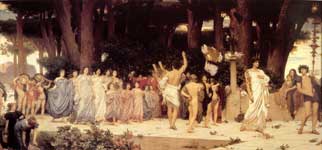

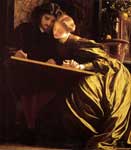

Fine Art Prints | Greeting Cards | Phone Cases | Lifestyle | Face Masks | Men's , Women' Apparel | Home Decor | jigsaw puzzles | Notebooks | Tapestries | ...
Frederic Leighton, 1st Baron Leighton PRA (3 December 1830 – 25 January 1896), known as Sir Frederic Leighton between 1878 and 1896, was an English painter and sculptor. His works depicted historical, biblical, and classical subject matter. Leighton was bearer of the shortest-lived peerage in history; after only one day his hereditary peerage ended with his death.[1]
Biography
Leighton was born in Scarborough to a family in the import and export business. He was educated at University College School, London. He then received his artistic training on the European continent, first from Eduard von Steinle and then from Giovanni Costa. When he was 24 he was in Florence; he studied at the Accademia di Belle Arti, and painted the procession of the Cimabue Madonna through the Borgo Allegri. From 1855 to 1859 he lived in Paris, where he met Ingres, Delacroix, Corot and Millet.
In 1860, he moved to London, where he associated with the Pre-Raphaelites. He designed Elizabeth Barrett Browning's tomb for Robert Browning in the English Cemetery, Florence in 1861. In 1864 he became an associate of the Royal Academy and in 1878 he became its President (1878–96). His 1877 sculpture, Athlete Wrestling with a Python, was considered at its time to inaugurate a renaissance in contemporary British sculpture, referred to as the New Sculpture. His paintings represented Britain at the great 1900 Paris Exhibition.
Leighton was knighted at Windsor in 1878,[2] and was created a baronet, of Holland Park Road in the Parish of St Mary Abbots, Kensington, in the County of Middlesex, eight years later.[3] He was the first painter to be given a peerage, in the New Year Honours List of 1896. The patent creating him Baron Leighton, of Stretton in the County of Shropshire, was issued on 24 January 1896;[4] Leighton died the next day of angina pectoris.
Leighton remained a bachelor and rumours of his having an illegitimate child with one of his models in addition to the supposition that Leighton may have been homosexual continue to be debated today.[5] He certainly enjoyed an intense and romantically tinged relationship with the poet Henry William Greville whom he met in Florence in 1856.[6]
The older man showered Leighton in letters, but the romantic affection seems not to have been reciprocated.
Sir Frederick Leighton by George Frederic Watts
Enquiry is furthermore hindered by the fact that Leighton left no diaries and his letters are telling in their lack of reference to his personal circumstances. No definite primary evidence has yet come to light that effectively dispels the secrecy that Leighton built up around himself, although it's clear that he did court a circle of younger men around his artistic studio.[5]
After his death his Barony was extinguished after existing for only a day; this is a record in the Peerage. His house in Holland Park, London has been turned into a museum, the Leighton House Museum. It contains many of his drawings and paintings, as well as some of his former art collection including works by Old Masters and his contemporaries such as a painting dedicated to Leighton by Sir John Everett Millais. The house also features many of Leighton's inspirations, including his collection of Iznik tiles. Its centrepiece is the magnificent Arab Hall. The Hall is featured in issue ten of Cornucopia.[7] A blue plaque commemorates Leighton at Leighton House Museum.[8]
Leighton was an enthusiastic volunteer soldier, enrolling with the first group to join the 38th Middlesex (Artists) Rifle volunteers (later to be known as The Artists Rifles) on 5 October 1860.
Sir Frederick Leighton, later in his career.
His qualities of leadership were immediately identified and he was promoted to command A Company within a few months. On 6 January 1869 Captain Leighton was elected to command The Artists Rifles by a general meeting of the Corps. In the same year he was promoted to Major and in 1875 to Lieutenant Colonel. Leighton resigned as Commanding Officer in 1883. The painter James Whistler famously described the then, Sir Frederic Leighton, the Commanding Officer of The Artists Rifles, as the: “Colonel of the Royal Academy and the President of the Artists Rifles – aye, and he paints a little!" At his funeral, on 3 February 1896, his coffin was carried into St Paul's Cathedral, past a guard of honour formed by The Artists Rifles.[9]
Honours timeline
1864 – Associate of the Royal Academy
1868 – Royal Academy Academician
1878 – President of the Royal Academy
1878 – Légion d'honneur Officer
1878 – Knight Bachelor
1886 – Created a baronet in the Baronetage of the United Kingdom
1889 – Associate member of the Institute of France
1896 – Created a baron in the Peerage of the United Kingdom
Selected works
Cimabue's Celebrated Madonna is carried in Procession through the Streets of Florence, 1853–1855
Daphnephoria, oil on canvas painting, 1874–1876, Lady Lever Art Gallery
Death of Brunelleschi (1852), oil on canvas
The Fisherman and the Siren, c. 1856–58 (66.3 x 48.7 cm)
Cimabue's Celebrated Madonna is carried in Procession through the Streets of Florence (1853–55),[10] oil on canvas.
The Discovery of Juliet Apparently Lifeless (c.1858)[11]
The Villa Malta, Rome (1860s),[12] oil on canvas
The Painter's Honeymoon, c. 1864 (83.8 x 77.5 cm)
Mother and Child, c. 1865, (48.2 x 82 cm)
Actaea, the Nymph of the Shore (1868),[13] oil on canvas, (57.2 x 102.2 cm) National Gallery of Canada, Ottawa.
Daedalus and Icarus, c. 1869, (138.2 x 106.5 cm)
Hercules Wrestling with Death for the Body of Alcestis (1869–71) (132.4 x 265.4 cm)
Greek Girls Picking up Pebbles by the Sea, 1871 (84 x 129.5 cm)
Teresina (circa 1874) Christchurch Art Gallery Te Puna o Waiwhetu, Christchurch, New Zealand
Music Lesson, c. 1877, (92.8 x 118.1 cm)
An Athlete Wrestling with a Python (1877),[14] bronze sculpture
Nausicaa, c. 1878 (145 x 67 cm)
Winding the Skein, c. 1878, (100.3 x 161.3 cm)
Light of the Harem, c. 1880, (152.4 x 83.8 cm)
Idyll, c. 1880–81
Wedded, (c. 1881–1882) (145.4 x 81 cm)
Cymon and Iphigenia (1884) Art Gallery of New South Wales
Captive Andromache, c. 1888 (197 x 406.5 cm)
The Bath of Psyche, (c. 1889–90) (189.2 x 62.2 cm) Tate Gallery
The Garden of the Hesperides, c. 1892, (169 x 169 cm)
Flaming June (1895), oil on canvas, Museo de Arte de Ponce, Puerto Rico (120.6 x 120.6 cm)
The Parable of the Wise and Foolish Virgins (Fresco)[15]
The armlet
Phoebe (55.88 x 60.96 cm)
A Bather
The Leighton Frescoes, The Arts of Industry as Applied to War and The Arts of Industry as Applied to Peace
See also
External video Leighton Athlete Wrestling with a Python 01 Tate Britain.jpg
Leighton's An Athlete Wrestling with a Python, Smarthistory
Romola – the novel by George Eliot for which he did the illustrations
Notes
Peerage records – Leigh Rayment's Peerage Page
The London Gazette: no. 24651. p. 6695. 29 November 1878.
The London Gazette: no. 25551. p. 328. 22 January 1886.
The London Gazette: no. 26705. p. 587. 31 January 1896.
Emanuel Cooper, The Sexual Perspective: Homosexuality and Art in the Last 100 Years in the West, 2005
Oxford Dictionary of National Biography vol 33
Cornucopia 10, Ingres and Lady Mary Montagu, Leighton House, yurts, the Lycians plus elegant eggplant. Cornucopia.net. Retrieved on 20 February 2011.
"LEIGHTON, FREDERICK, LORD LEIGHTON (1830–1896)". English Heritage. Retrieved 1 July 2012.
Barry Gregory. A History of The Artists Rifles 1859–1947. Pen & Sword. 2006.
Frederic, Lord Leighton | Cimabue's Celebrated Madonna | L275 | The National Gallery, London. Nationalgallery.org.uk. Retrieved on 20 February 2011.
Tate Collection | Study for 'The Discovery of Juliet Apparently Lifeless'. Tate.org.uk. Retrieved on 20 February 2011.
Frederic, Lord Leighton | The Villa Malta, Rome | L851 | The National Gallery, London. Nationalgallery.org.uk. Retrieved on 20 February 2011.
Artwork Page: Actaea, the Nymph of the Shore. Cybermuse.gallery.ca. Retrieved on 20 February 2011.
Tate Collection | An Athlete Wrestling with a Python by Frederic, Lord Leighton. Tate.org.uk. Retrieved on 20 February 2011.
Newforestparishes.com
References
Public Domain This article incorporates text from a publication now in the public domain: Chisholm, Hugh, ed. (1911). "Frederick_Leighton,_Baron_Leighton". Encyclopædia Britannica (11th ed.). Cambridge University Press.
----
Fine Art Prints | Greeting Cards | Phone Cases | Lifestyle | Face Masks | Men's , Women' Apparel | Home Decor | jigsaw puzzles | Notebooks | Tapestries | ...
----
Artist
A - B - C - D - E - F - G - H - I - J - K - L - M -
N - O - P - Q - R - S - T - U - V - W - X - Y - Z
Retrieved from "http://en.wikipedia.org/"
All text is available under the terms of the GNU Free Documentation License



























